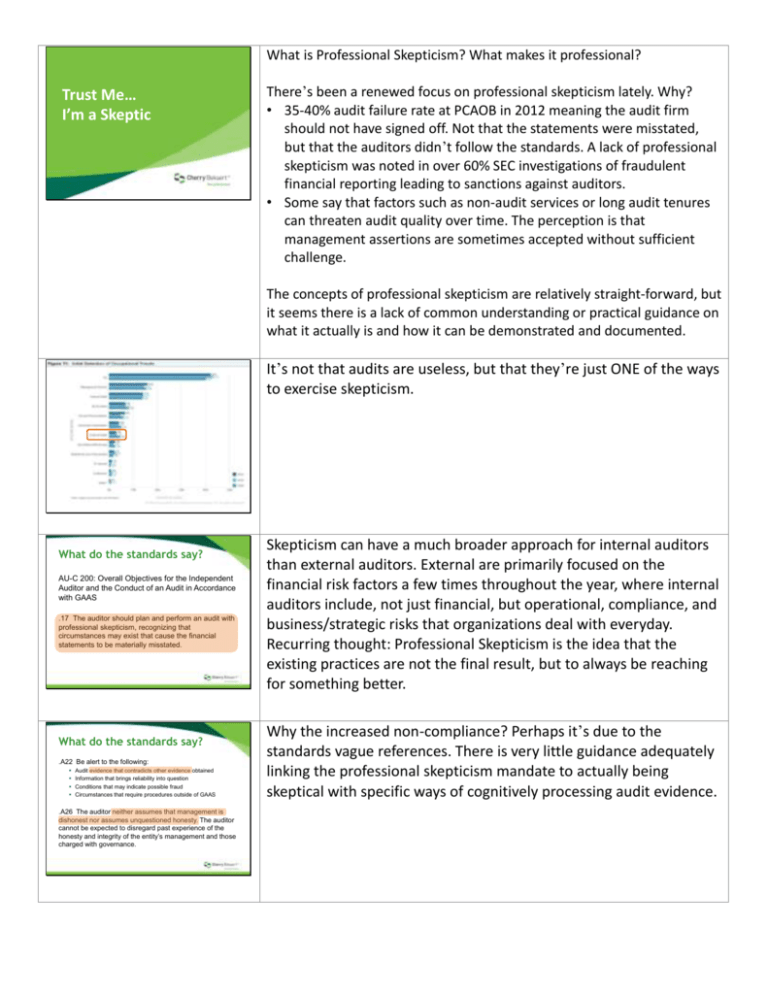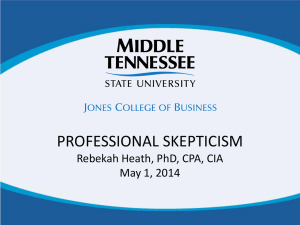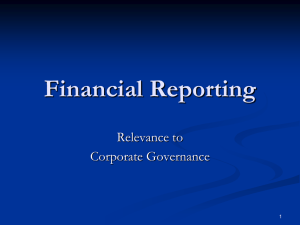Trust Me... I`m a Skeptic
advertisement

What is Professional Skepticism? What makes it professional? Trust Me… I’m a Skeptic There’s been a renewed focus on professional skepticism lately. Why? • 35-40% audit failure rate at PCAOB in 2012 meaning the audit firm should not have signed off. Not that the statements were misstated, but that the auditors didn’t follow the standards. A lack of professional skepticism was noted in over 60% SEC investigations of fraudulent financial reporting leading to sanctions against auditors. • Some say that factors such as non-audit services or long audit tenures can threaten audit quality over time. The perception is that management assertions are sometimes accepted without sufficient challenge. The concepts of professional skepticism are relatively straight-forward, but it seems there is a lack of common understanding or practical guidance on what it actually is and how it can be demonstrated and documented. It’s not that audits are useless, but that they’re just ONE of the ways to exercise skepticism. What do the standards say? AU-C 200: Overall Objectives for the Independent Auditor and the Conduct of an Audit in Accordance with GAAS .17 The auditor should plan and perform an audit with professional skepticism, recognizing that circumstances may exist that cause the financial statements to be materially misstated. What do the standards say? .A22 Be alert to the following: Audit evidence that contradicts other evidence obtained Information that brings reliability into question Conditions that may indicate possible fraud Circumstances that require procedures outside of GAAS .A26 The auditor neither assumes that management is dishonest nor assumes unquestioned honesty. The auditor cannot be expected to disregard past experience of the honesty and integrity of the entity’s management and those charged with governance. Skepticism can have a much broader approach for internal auditors than external auditors. External are primarily focused on the financial risk factors a few times throughout the year, where internal auditors include, not just financial, but operational, compliance, and business/strategic risks that organizations deal with everyday. Recurring thought: Professional Skepticism is the idea that the existing practices are not the final result, but to always be reaching for something better. Why the increased non-compliance? Perhaps it’s due to the standards vague references. There is very little guidance adequately linking the professional skepticism mandate to actually being skeptical with specific ways of cognitively processing audit evidence. What do the standards say? AU-C 240: Consideration of Fraud in a Financial Statement Audit .13 If conditions identified during the audit cause the auditor to believe that a document may not be authentic or that terms in a document have been modified but not disclosed to the auditor, the auditor should investigate further. .A9 Maintaining professional skepticism requires an ongoing questioning…particularly…when considering the risks of material misstatement due to fraud. Skeptikos To be reflective and inquisitive of all things. 1. Against every statement its contradiction may be advanced with equal justification 2. Preserve an attitude of intellectual suspense 3. The impossibility of knowledge So, let’s go to the beginning. The word itself actually means “to be reflective and inquisitive”. It’s different than constant doubt, but more of thinking critically and giving equal weight to the other side of every argument. Story of Pyrrho (360 BC - 270 BC) – Painter turned philosopher who traveled with Alexander the Great throughout India and Persia. He brought back the idea that nothing can be known for certain. The senses are easily fooled, and reason follows too easily our desires. Widely viewed as the first ‘skeptic’. Basically, he taught that nothing can be truly known. This is certainly true in the world of accounting where the sheer number of transactions and judgments required make it impossible to truly know just about anything. It’s the knowledge of not knowing that keeps us professionally skeptical. Two Main Views 1. Neutral Management is neither honest nor dishonest 2. Presumptive Doubt Management is guilty until proven innocent So, what does this have to do with auditing? We tend to stay in one of these two camps and varied practice is inevitable. One firm will have very different takes as a culture. Partners within those firms will do the same and individuals on audit teams add another layer of judgment. • Neutral – don’t assume management is either honest or dishonest, but rather, you keep in mind that fraud can be present. Most auditing standards leave us here. With this approach, auditor evaluates evidence carefully, but without a presumed carelessness, incompetence or fraud on management’s part. Many practitioners side with this approach, but can lead to overly high levels of detection risk • Presumptive Doubt – assume some dishonesty unless data indicates otherwise (opposite of innocent until proven guilty). This is where most regulators tend to land and can lead to an over accumulation of audit evidence and eliminate efficiencies gained by neutrality. Skepticism Continuum But, if we take skepticism more seriously, it gets more complicated than this. So maybe there’s another view… Six Ways to Skepticism 1. Suspension of Judgment 2. Search for Knowledge 3. Interpersonal Understanding 4. Questioning Mindset 5. Autonomy 6. Self-Esteem Definition: Withholding judgment until appropriate evidence is obtained. Suspension of Judgment How often do we start the audit assuming a clean opinion? With audit software linking just about everything there is, this is getting tougher to do. We’ll talk about the anchoring bias later. PCAOB’s audit failure observations note that, in most cases, the compromising evidence was IN THE WORKPAPERS. The audit team noted the issue and concluded against it. This typically isn’t new information, but a lack of mindset for the auditors. They WANT there to be no issues. Definition: A desire to investigate beyond the obvious, with a desire to corroborate. Search for Knowledge • Asking 5 Why’s • Is SAS 99 dead? When you’re conducting a fraud interview, how seriously are your people/clients taking them? Is there a hope that you don’t find things so that you don’t have to do more work? When do you conduct these interviews? At the end of fieldwork, during, or before planning? When discrepancies do appear, are you more vigilant in finding a way around them so you can meet budget and not have to alter your original audit plan? The Broken Machine Hey boss! The time system is down. When confronted with a problem, researchers have found it takes an average of asking ‘why’ 5 times to get to the root cause. Wait what? Why? Because a particular server failed. Why did it fail? Definition: Recognition that people’s motivations and perceptions can lead them to provide biased or misleading information. Interpersonal Understanding • Are communication skills getting worse? • There’s a lot to be gained from face-to-face meetings, yet many new staff are caught in an impersonal trap. • There’s no app for auditing • We are finding that future generations of auditors develop and exercise professional skepticism differently than more experienced auditors • Reinforce the importance of interviewing and inquiry skills in the audit process, including consideration of non-verbal cues. Autonomy Definition: The self-direction, moral independence, and conviction to decide for oneself, rather than accepting the claims of others. Autonomy / Self-Esteem Self-Esteem Definition: The self-confidence to resist persuasion and to challenge assumptions or conclusions. There is a generation gap where junior auditors simply take the word of an older, more experienced auditor. Are your people confident? The Dangers of Groupthink Groupthink (where individuals suppress their own views because of an assumption that consensus in the group signals good judgment) – this can especially be true in cases where a prominent member of the group expresses his/her views early. • Both US and International auditing standards require brainstorming sessions. Research, however, suggests that group brainstorming sessions can actually inhibit professional skepticism due to groupthink. • How to overcome – • Leader of the meeting sets tone by encouraging diversity of thought • Auditors come to the meeting with identified risks and potential audit responses prior to the meeting • Flip the meeting. In Japan, many businesses require the lower level employees to begin the brainstorming while the executives stay silent. Then, the next level speaks and on up the chain until the executives are the last to speak. • A Schaub & Lawrence study in early 1999 showed that, in many cases, the level of skepticism is highest among staff and seniors than in managers and partners. • Quickest thinking from a group can lead to extreme overconfidence (more on this later) • Fostering healthy debate and avoiding early consensus is key to avoiding unhealthy tendencies toward suppression of views or early, potentially premature, consensus. • Do you encourage and stimulate debate and different perspectives? Barriers and Biases The human mind is capable of solving incredibly complex problems and developing new and creative solutions. 1. Anchoring 2. Availability 3. Confirmation Yet, that same mind can be subject to predictable judgment traps and biases. This does not mean that auditors are bad as much as it means that they are simply human. 4. Overconfidence Anchoring Bias The tendency to make assessments in gathering and evaluating information by starting from an initial value and then adjusting insufficiently away from that initial value in forming a final judgment. This is commonly exhibited when auditors begin the audit of a specific account by viewing the account details from the previous year or by examining unaudited balances. This quickly taints our ability to think skeptically and objectively about our expectations of the actual results. This is why we hear salesmen start with “These services are worth $200, but I’m offering them to you for only $99.” Once we’re anchored, we have a tendency to not move very far from that initial number. Think about how this can impact our analytics. This is why it’s so important to develop an expectation BEFORE we see any numbers. The fact is, we are heavily and unconsciously swayed by information. When conducting analytics, expectations, risk assessments; be sure to consider what information might be affecting your process. You might say nothing is, but the people in the above survey felt the same way. Each participant was to determine the appropriateness of interest income using 2 different methods. Materiality was set at $525,000 (4.2% of Net Income). Test Tube Auditing Participants 67 seniors from a Big Four firm 34.5 months of audit experience 2 Audit Tests AGGREGATED – All participants were asked to calculate expected annual interest income for hypothetical bank using annual loan receivable balances and a weighted average annual interest rate for all loan categories combined. Participants were given a copy of the PY analysis. Aggregated Disaggregated 2 Groups Significant Difference No Significant Difference DISAGGREGATED – After doing this, they were asked to calculate expected annual interest income using quarterly loan receivable balances and weighted average quarterly interest rates by loan category (ex. Commercial, real estate, individual, etc.). Significant Difference Group: These auditors would calculate interest income that would differ materially ($792,300) from what the client recorded during the AGGREGATE test. Test Tube Auditing Aggregate Procedure Disaggregate Procedure No Significant Difference Significant Difference Significant Difference Assess Evidential Strength Assess Evidential Strength Reassess Strength of Part A No Significant Difference Group: These auditors would calculate interest income that would not differ materially ($146,200) from what the client recorded during the AGGREGATE test. Assess Evidential Strength – Participants were asked 3 questions: • Can you accept interest income as reported? • What is the likelihood that interest income was materially misstated on a scale of 0 to 100 (where 100 was labeled “definitely misstated”)? • Evaluate the strength of the evidence provided by the interest income analytical procedure on a 7 point scale (where 0 is Extremely Weak/Useless and 7 is Extremely Strong/Removes all doubt). Glover, Prawitt, Wilks, 2004 After Disaggregated Procedure, participants were asked the same 3 questions and one additional question: Now reevaluate the analytical procedure used in Part A. Please indicate on a scale of 1-7 the strength of evidence provided by the interest income analytical procedure in Part A. Evidential strength: 1 (extremely weak) to 7 (extremely strong) Test Tube Auditing Estimates of Evidential Strength for Part A-Aggregate Procedure (Initial Assessment) Part B-Disaggregated Procedure – Suggests Material Misstatement Aggregate Procedure (Reassessment) No Significant Difference 3.9 (0.81) [29] 3.7 (0.99) [29] 2.7 (1.16) [29] Significant Difference 2.9 (1.02) [36] 3.8 (1.03) [36] 2.8 (1.21) [36] 3.4 3.8 2.8 Outcome of Aggregate Analytical Procedure Combined Glover, Prawitt, Wilks, 2004 Overconfidence So, we find that auditors attributed significantly more evidential strength to a weak analytical procedure that suggested no significant difference than to an identical procedure based on the same underlying data that suggested a potential misstatement. Further, when the auditors in the no-significant-difference condition reconsidered the aggregated analytical procedure after conducting stronger, more precise analytical procedures based on disaggregated data, they significantly reduced their strength of evidence ratings for the aggregate analytical procedure, while auditors in the significant difference condition did not. The tendency of decision makers to overestimate their own abilities to perform tasks or make accurate assessments of risk or other judgments and decisions. Someone who knows they may not know, can stop. Overconfidence tempts you to make decisions without adequate reflection. We all have the sense that we know better. We know where the risks are. When the opinion is signed, we’ve thought of everything. And if it falters, it was someone else’s fault. Humans have an uncanny tendency to feel overly awesome. Do you do better audit work than your competitors? Do you work harder than most at your company? Most of us greatly overestimate our looks, intelligence, morals, etc. In one survey, more people claimed they thought they were going to heaven than thought Mother Theresa was. Trust Me… I’m a Skeptic Jonathan Kraftchick jkraftchick@cbh.com @jkraftchick








